Star and Planet Formation and Evolution, and the Search for Life
The NRAO facilities remain the work-horse radio observatories for study of the physics and chemistry of star and planet formation in the Milky Way and nearby galaxies.
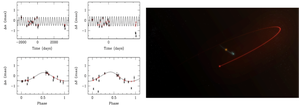
Thousands of planets are now known, but study of planetary orbits in common binary star systems remains under-explored. Precision (tens of mas) astrometry at 8 GHz with the VLBA has traced the 3D structure of the orbits of the binary star system, GJ896AB, consisting of 0.4Mo and 0.2Mo stars with an orbital period of 229 days at Neptunian separation. Both dwarf stars are magnetically active and have sub-mJy, variable radio emission. The motion of star A implies a 2MJup planet orbiting with a period of 284 days at a Venusian distance. The surprise was that the planet is in retrograde orbit relative to the binary stars. Seeing such a large planet in a retrograde orbit in a very compact binary system challenges theories of planet formation (Figure 4; Curiel et al. 2022, AJ, 164, 92).
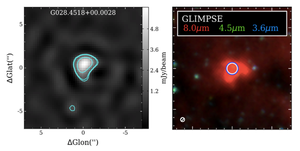
This year saw the publication of results from the Global View of Star Formation in the Milky Way (GLOSTAR; Figure 5; Dzib et al. 2022) large program at the VLA. GLOSTAR is a survey of a large region of the Galactic plane at 4–8 GHz with an unprecedented resolution and sensitivity of 1” and 60mJy. Almost 1500 radio sources are identified at high significance, including radio stars, planetary nebulae, and HII regions associated with both young stellar objects in clusters and with massive stars. The results have wide impact on areas ranging from stellar atmospheres to the birth and death of stars.
Results from the ALMA Molecules with ALMA at Planet-forming Scales (MAPS) Large Project target were published this year. An important result was the discovery of a circumplanetary disk (CPD) associated with accretion onto a forming planet in the dusty circumstellar disk around the T Tauri star AS209 (Bae et al. 2022, ApJ 934, 20). The CPD is less than 14 AU in size, and is located 200 AU from the parent star. The planet was isolated by velocity perturbations seen in the 13CO J=2-1 emission. The velocity field suggests kinematic influence of an embedded giant planet of about 0.1MJup; the data also suggest localized gas heating. The age of the system is only one to two million years, implying a very young exoplanet. ALMA also detected a dusty accretion disk around the T Tauri binary star system, SR 12 c. This system has an 11 MJup planetary-mass companion orbiting 980 AU from its host binary (Wu et al. 2022, ApJ 930, 3). In contrast to AS209, seen only in line emission, the SR 12 disk was seen only in dust emission.
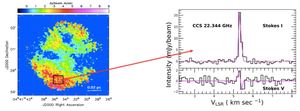
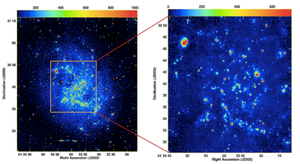
The VLA has completed a survey of the M33 galaxy (Figure 7; Tabatabaei et al. 2022) at 1.5 GHz and 6.3 GHz, with resolutions down to 30pc, sufficient to isolate individual giant molecular clouds (GMC)—the dominant sites for star formation in galaxies. The broadband, multifrequency observations allow for a separation of thermal and non-thermal emission. The results provide the most detailed, dust-unbiased measure of the star formation law relating star formation rate to molecular gas content of GMCs. The non-thermal emission provides details as to the generation of magnetic fields via a turbulent dynamo driven by star formation and supernovae.
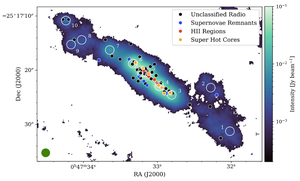
The ALMA Comprehensive High-resolution Extragalactic Molecular Inventory (ALCHEMI; Figure 8; Behrens et al 2022) Large Program at ALMA provides a multi-band, beam-matched spectral scan of the Central Molecular Zone (CMZ; 850x340pc) of the starburst galaxy NGC253 at GMC resolution (1"=17pc). Five papers this year provide a molecular inventory via reliable templates of chemistry and excitation in one of the closest nuclear starburst galaxies at GMC scales. These papers find major differences in the CMZ relative to the rest of the galaxy disk, including (i) greatly enhanced cosmic ray density, (ii) orders of magnitude lower gas-phase CO2 abundance at the galaxy center, and (iii) efficient CO2 sublimation onto ice grains. These differences likely result from the very high star formation rate along the CMZ.
Numerous large programs on star and planet formation are underway at ALMA and the VLA. These include a comprehensive study of the Orion star forming region, very high resolution imaging of sub-structure in proto-planetary disks, continued exploration of the gas and chemistry of proto-planetary disks, and determination of the bulge structure on the far side of the Galaxy.




Connect with NRAO